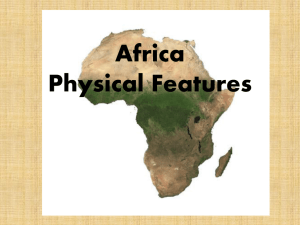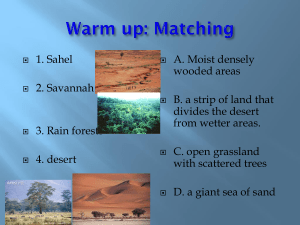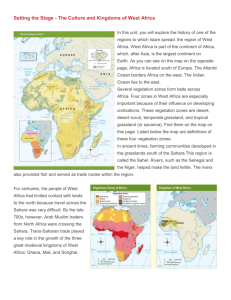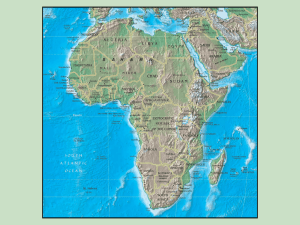Early Societies in West Africa
advertisement
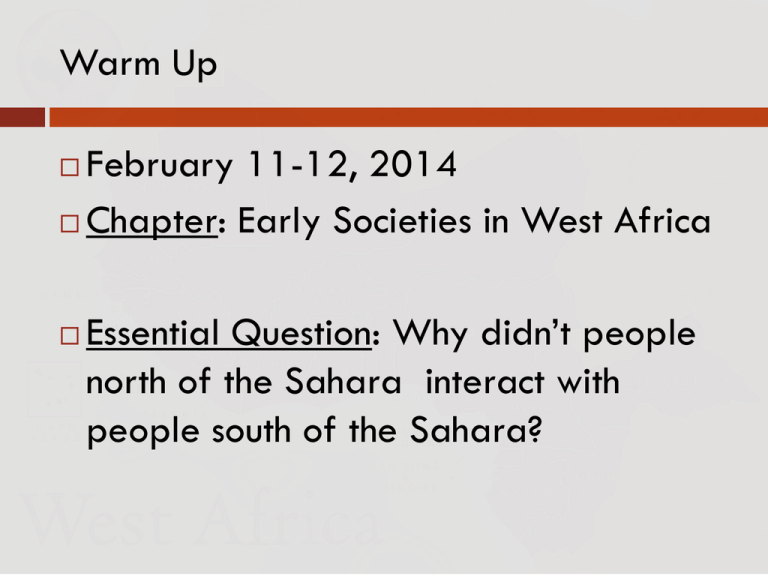
Warm Up February 11-12, 2014 Chapter: Early Societies in West Africa Essential Question: Why didn’t people north of the Sahara interact with people south of the Sahara? EARLY SOCIETIES IN WEST AFRICA History Alive! The Medieval World and Beyond: Chapter 12 A Long Unwritten Past People have lived in West Africa for hundreds of thousands of years. Due to only passing information orally for much of this time, we do not have written records. Muslim scholars began writing about the kingdom of Ghana in the 800s. It was at least 300 years old by then. Archeologists and historians look at various things for clues including: Geography – natural features like rivers and vegetation show where people settled. Artifacts – Objects that were left behind show various things such as farming methods and how people lived. We know that Africa went from family based communities to villages to towns to cities and then into great kingdoms. Geography and Trade West Africa has a wide range of geographical features: In the North is the Sahara Desert. South of the Sahara is the Sahel, which is dry but has enough water for short grasses and small bushes and trees. Next is the savannah, this area has tall grasses and trees with a long rainy season. The Niger river goes through this and then into woodlands and then rainforest. Sahara Desert Sahel Savannah Savannah Niger River Delta Niger River Rain Forest Geography and Trade cont. The wide variety of geographical features in Western Africa made no area self-sufficient, they needed to trade with other areas to get all the things they needed to survive. People in the forest would trade mahogany wood for grains from the savannah. Early Communities and Villages People started settling in farming communities around 4000 B.C.E. in the Sahel. These communities were made of extended families. An extended family includes close relatives such as grandparents as well as aunts, uncles, and their children. These communities would be about 15-20 people. Men typically made the decisions in these communities. Eventually these communities joined together to form villages, these would contain anywhere between 100 and 200 people. Discoveries of high walls suggest that villages were formed in order to create a common defense. The Development of Towns and Cities Villages often grew into towns and cities. This was due to two main reasons. Ironworking developed in 1500 B.C.E. by the Hittites in present day Turkey. This spread to Africa by 500 B.C.E. Iron tools allowed for more efficient farming which allowed for a surplus of food. One great city was the city of Jenne-jeno. Cities were located close to water ways. The Development of Towns and Cities cont. The surplus of food was then traded to gain goods that the communities could not develop themselves. People began moving to areas that trade was easy (near water or well traveled routes) and became wealthy. Africans prized iron more than gold and marveled at the blacksmiths’ creations, even considering them magical or godlike. The Rise of Kingdoms and Empires Kingdoms first developed as rulers of trading cities began collecting taxes and became very rich. They were then able to create very large and powerful armies to conquer foreign cities. They then would collect tribute from conquered areas. Tribute is a payment made by one ruler of country to another for protection or as a sign of submission. West African kings were considered to have special powers given to them by the gods. The Rise cont. There were disadvantages to those conquered into empires. Local rulers had to pay tribute. Local men had to fight in the king’s army. There were also advantages of those conquered into empires. Armies made trade safe, and kept raiders and foreign armies out of the cities. Loot from conquered cities was often passed fairly throughout the kingdoms. Work citied History Alive! The Medieval World and Beyond: Chapter 12 http://www.heartefakte.de/Weitere%20Angebote/SpeerEisen.JPG http://www.viamigo.com/img/l/p_o_s_t/54/mauritaniaancient-cities.jpg http://picnica.ciao.com/de/25210332.jpg http://www.ruf.rice.edu/~anth/arch/niger/jj-backmap.jpg http://www.crystalinks.com/meroticelephant.jpg http://i7.photobucket.com/albums/y282/idsguy/Wallachia nHorseman.jpg?t=1240172397 http://savannainafrica.files.wordpress.com/2012/01/african-savannahzebras-wall-inkbluesky6.png http://www.ezakwantu.com/Gallery%20African%20Weapons%20%20Central%20African%20Weapons.htm http://www.mii.org/Minerals/Minpics1/Goethite.jpg http://eol.jsc.nasa.gov/sseop/EFS/printinfo.pl?PHOTO=STS61C-42-72 http://www.arcticphoto2.co.uk/pixsets/congo/cng18040608.htm http://www.georgesteinmetz.com/image_collections/africanportfolio/main/STNMTZ_20041001_02A.JPG http://eco-gold.org/images/ecogold_14a.jpg http://www.gowestafrica.org/images/wamap_web_large.jpg








